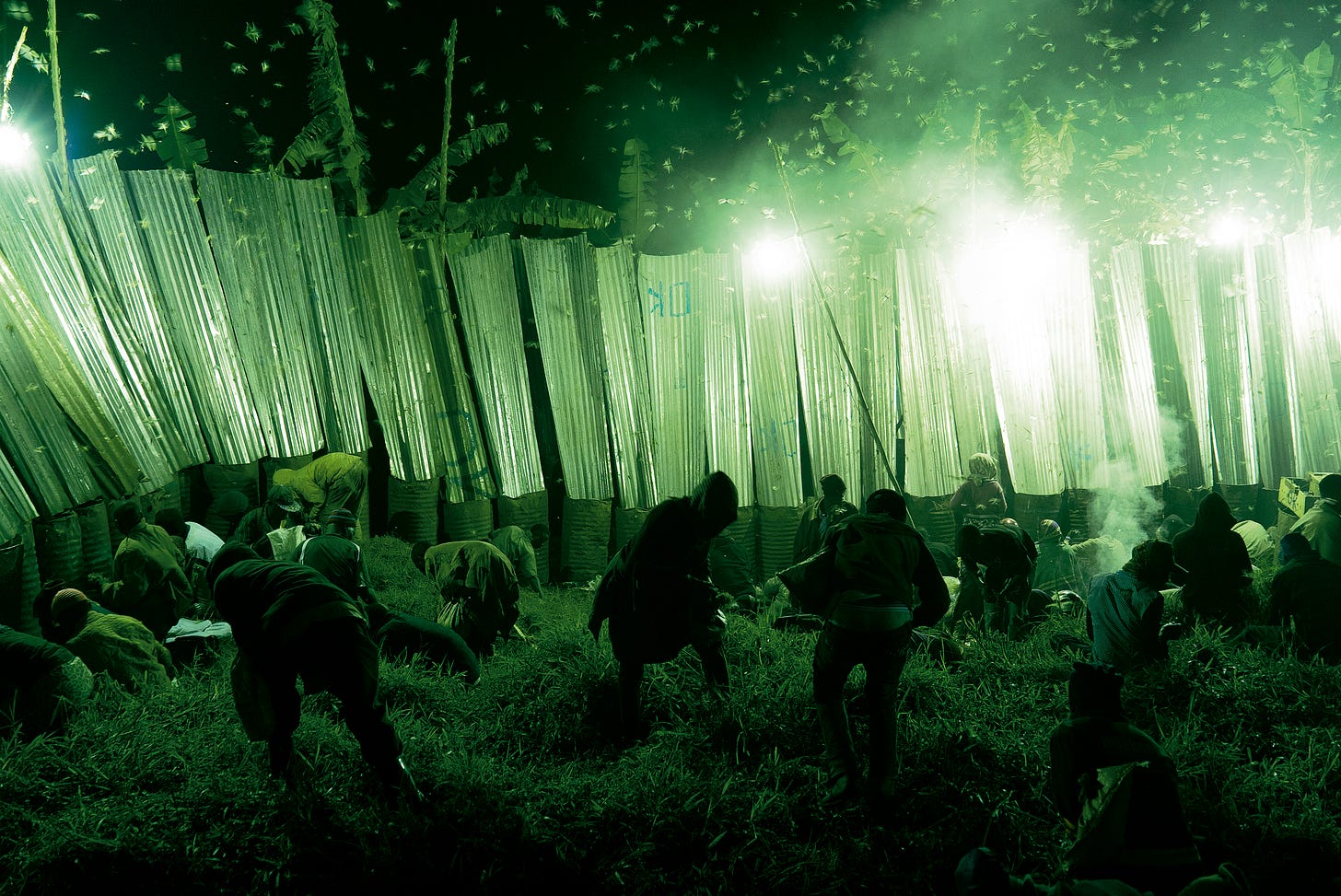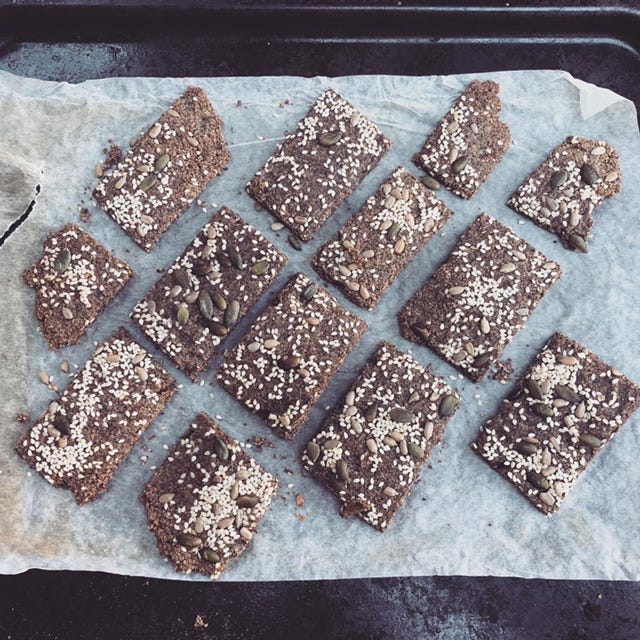Buzzing: Three insects a crowd?
Hello friends, how are you all this week? A quick reminder that I am now accepting classified ads, so do drop me a line for details if you’d like to advertise job vacancies, events, calls for proposals etc.
Today in Buzzing:
Should we farm just three species of insects?
In Other News: Stunning Nsenene images
Test Corner: Better crickety crackers
A couple of issues ago, I mentioned that I’d attended the AGM of the North American Centre for Insect Agriculture (NACIA), which had provided plenty of food for thought. One session was set up as a “reverse pitch”, whereby industry professionals “pitched” to academia the areas they were keen to see more research on and those they weren’t.
Things the insect sector wanted to see more of included anything with long timelines, assessments of commercially available feedstocks, and pests and pathogens. “We won’t introduce [pests and pathogens] to our colonies but we would love to infect yours and see what happens,” quipped incoming NACIA president Virginia Emery, CEO of Beta Hatch.
Top of the list on the “don’t research” list was research on new insect species. That surprised me. The insects as food and feed industry is currently dominated by three species: house crickets (Acheta domesticus); black soldier fly (Hermertia illucens); and yellow mealworm (Tenebrio molitor). There are a few more in the mix – other species of crickets and mealworms, locusts, cockroaches and silkworm in China – but the cricket-mealworm-BSF trio is king in the emerging insect farming industry of the developed world.
In some ways, it makes sense: domesticating an animal is no mean feat. It takes years to develop farming protocols, processing techniques, suitable feeds, etc. Also, we’re still far from knowing everything about the species we already farm, especially their nutritional and antimicrobial benefits. Diverting efforts to new species would therefore be a distraction.
On the other hand, focusing on just three insects when there are more than 2,000 species of edible insects feels incredibly reductive. “The insect industry is like: ‘there are three insect species and one type of substrate [pre-consumer waste] and that’s it’,” a frustrated Olympia Yarger of Goterra told me earlier this year.
Goterra currently farms BSF, which it rears on food waste and uses as a waste management system, but Yarger says that she is genuinely interested in using different species for different purposes. “I don’t even want to limit myself by naming one: we work with capable researchers on this.”
My own view is that we need to farm a greater diversity of insects, and in a greater variety of ways. We absolutely need the large farms in Europe and North America (and the deep research that goes with it), but we also need smaller urban farms, farming models adapted to developing markets, semi-wild rearing systems for rural communities and even the development of sustainable frameworks for wild harvesting, an idea entomologist and doyenne of the edible insect movement Prof Florence Dunkel of Montana State University recently put to me.
That should keep researchers everywhere very busy.
In Other News
Graphic story
These stunning images of nsenene (Ruspolia differens), Uganda’s most popular edible insect, were taken by Italian photographer Michele Sibiloni. Sibiloni lived in Uganda for 10 years and got to witness the nsenene harvest many times. The harvest is done at night, using powerful lamps and smoke to attract and confuse the insects. His beautiful, sometimes surreal, photographs are now collated in a book called Nsenene, which also includes three essays by Ugandan personalities with deep connections to the grasshoppers. The book is published by Editions Patrick Frey and can be purchased here: US, EU, UK.

Sector news
Better Origin are installing 10 of their containerised Black Soldier Fly units on free range egg farms that supply supermarket chain Morrison. (FT)
The ValuSect consortium opens its second call for interest to receive vouchers on 6 December 2021. A budget of €440.000 is available in the form of services for SMEs located in North-West Europe.
This was something of a curiosity: even though cockroach farming is legal in China, farms keep a low profile because people would rather not have 1 billion roaches as their neighbours. (Interesting Engineering)
Test Corner: Better crickety cracker
Back in March, I wrote about a batch of cricket crackers I’d made. I thought they tasted great but that their texture was too soft. So I decided to make another batch, with a few tweaks.
The crackers are basically all seeds and a little bit of water. The total seed content in the dough is 200g and the original recipe called for 50g of flaxseed: since this is the binding seed in the mix, I upped the content to 70g this time.
The other modification I made was with the crickets: I went for 40g and used whole crickets instead of powder. The remaining 90g was a mix of sunflower seeds, pumpkin seeds and sesame seeds (with another three tablespoons for the topping). Finally I decided to bake the crackers at a higher temperature.
I think the new mix worked really well: the crackers were firmer and the flavour spot on. They do get softer with time but a batch is usually gone within a day or two in my house.
So here is the recipe. It is endlessly customisable (change the seeds/spices/herbs). It takes about 10 min to make 😊
70g flaxseeds
40g whole crickets
90g mix of seeds (sunflower, pumpkin, sesame, poppy etc)
3 tbsp mixed seeds for the topping
½ tsp salt
½ tsp spices or dried herbs of your choice.
Put all the ingredients in the food processor (except the 3tbsp for the topping) and blend to a powder. Add 60ml of water and turn into a rough dough. Roll out between two sheets of baking paper to a thickness of 1-2mm. Sprinkle the seeds topping, press into the dough. Pre-cut the crackers to the desired size with a pizza wheel or a large knife. Bake for 25 min at 180C.






This is a great post, especially the section on farming just three species. Definitely agree with you that it feels reductive.
My husband works for the NRCS, part of the USDA, and I end up forwarding him most of your posts, including this one. Is the USDA involved in any insect research that you're aware of? (It would really surprise me if the answer was no, but then again, I am expecting the answer to be no.)
I'd love to try your cracker recipe but have no idea where to get crickets! Do you buy yours locally somewhere, or order them online, or catch them, or....?